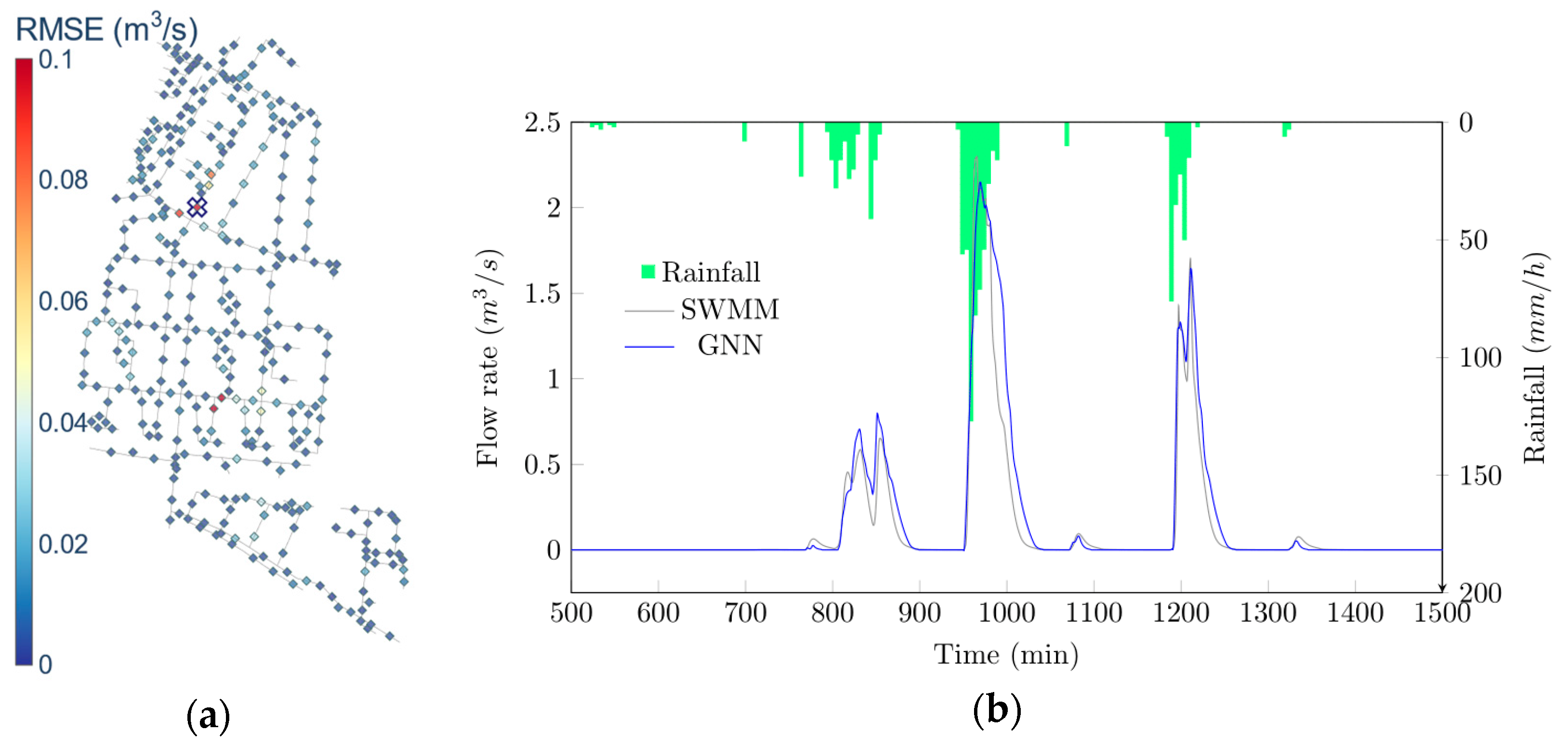Accelerating Urban Drainage Simulations: A Data-Efficient GNN Metamodel for SWMM Flowrates †
Abstract
:1. Introduction
2. Materials and Methods
Training Strategy
3. Results
4. Conclusions
Author Contributions
Funding
Data Availability Statement
Acknowledgments
Conflicts of Interest
References
- Garzón, A.; Kapelan, Z.; Langeveld, J.; Taormina, R. Machine Learning-Based Surrogate Modelling for Urban Water Networks: Review and Future Research Directions. Water Resour. Res. 2022, 58, e2021WR031808. [Google Scholar] [CrossRef]
- Garzón, A.; Kapelan, Z.; Langeveld, J.; Taormina, R. Transferable and Data Efficient Metamodeling of Storm Water System Nodal Depths Using Auto-Regressive Graph Neural Networks. Water Res 2024, 122396. [Google Scholar] [CrossRef]
- Brandstetter, J.; Worrall, D.; Welling, M. Message Passing Neural PDE Solvers. arXiv 2022, arXiv:2202.03376. [Google Scholar]
- Hu, W.; Liu, B.; Gomes, J.; Zitnik, M.; Liang, P.; Pande, V.; Leskovec, J. Strategies for Pre-Training Graph Neural Networks. arXiv 2019, arXiv:1905.12265. [Google Scholar]
- Palmitessa, R.; Grum, M.; Engsig-Karup, A.P.; Löwe, R. Accelerating Hydrodynamic Simulations of Urban Drainage Systems with Physics-Guided Machine Learning. Water Res. 2022, 223, 118972. [Google Scholar] [CrossRef] [PubMed]


| ) | Overall | Flow | No Flow |
|---|---|---|---|
| Mean SD | 1.82 1.10 | 10.5 7.18 | 0.17 0.15 |
| Max | 4.42 | 28.6 | 0.580 |
| Min | 0 | 0.23 | 0 |
Disclaimer/Publisher’s Note: The statements, opinions and data contained in all publications are solely those of the individual author(s) and contributor(s) and not of MDPI and/or the editor(s). MDPI and/or the editor(s) disclaim responsibility for any injury to people or property resulting from any ideas, methods, instructions or products referred to in the content. |
© 2024 by the authors. Licensee MDPI, Basel, Switzerland. This article is an open access article distributed under the terms and conditions of the Creative Commons Attribution (CC BY) license (https://creativecommons.org/licenses/by/4.0/).
Share and Cite
Garzón, A.; Kapelan, Z.; Langeveld, J.; Taormina, R. Accelerating Urban Drainage Simulations: A Data-Efficient GNN Metamodel for SWMM Flowrates. Eng. Proc. 2024, 69, 137. https://doi.org/10.3390/engproc2024069137
Garzón A, Kapelan Z, Langeveld J, Taormina R. Accelerating Urban Drainage Simulations: A Data-Efficient GNN Metamodel for SWMM Flowrates. Engineering Proceedings. 2024; 69(1):137. https://doi.org/10.3390/engproc2024069137
Chicago/Turabian StyleGarzón, Alexander, Zoran Kapelan, Jeroen Langeveld, and Riccardo Taormina. 2024. "Accelerating Urban Drainage Simulations: A Data-Efficient GNN Metamodel for SWMM Flowrates" Engineering Proceedings 69, no. 1: 137. https://doi.org/10.3390/engproc2024069137







